In a sense then, our own iconic symbol can convey the kind of unique educational experience we hope to provide to our students. We might say that the letter Y explains why—W-H-Y—we exist and what we hope to accomplish.
The theme of this year’s BYU annual university conference comes from Doctrine and Covenants 128, which is a letter written by Joseph Smith to the Saints in September 1842. It is in the form of a rhetorical question: “Shall we not go on in so great a cause?”—the implicit answer being, “Of course!”1
The particular cause that Joseph was addressing when he wrote this inspired epistle was baptism for the dead—a great cause indeed. The cause in which we are now engaged is a different one. Or, more correctly, it is a different part of the same great cause—the greatest cause of all—the overarching cause of all of God’s work “to bring to pass the immortality and eternal life”2 of His children.
That our work at Brigham Young University is part of this greater cause is made clear by the opening sentence of our Brigham Young University mission statement, which plainly states that our main purpose “is to assist individuals in their quest for perfection and eternal life.”3 Those who have heard me speak in the past three months will not be surprised to hear me start with the mission statement. That document, to use the words of Joseph, “seems to occupy my mind, and press itself upon my feelings the strongest”4 since I was appointed president.
This morning I would like to review with you some of the key principles in our mission statement with the ultimate aim of helping us better understand the great cause in which we are engaged and the ways in which each of us can better carry out our roles in this cause.
Let me begin by highlighting one of the key principles of the mission statement—one that is found only implicitly in that document and, therefore, one that is possible to overlook, as obvious as it may seem. The principle is this: Our mission as a university focuses on the students.
While that exact statement does not appear anywhere in the mission statement, the document is founded on that assumption.
• The word students appears in the mission statement seven times.
• The word faculty appears twice.
• The terms administrators and staff appear only once each.
Although I am quite confident that the authors of the mission statement did not engage in a careful word analysis to ensure that the relative importance of each group was precisely represented in the numeric ratio of the nouns used in the document, I think noting these occurrences is not a bad way of reminding ourselves that our mission focuses on the students and not on us or on anyone else.
At the end of the day, students are the product we produce, to put it in business terms. How they turn out—what they do and, more important, who they are—is the ultimate metric by which our work will be measured.
And by that measure we are doing quite well. Our graduates are succeeding in the world of work, in their communities, and in their homes. But lest we become puffed up in unrighteous pride for things not of our own doing, let me remind you that we start with very good raw material, so to speak.
As a result of their own gifts and hard work as well as the loving nurture of families and communities, our students are extraordinary people even before they arrive on campus—before we have had any impact at all on them. Just to give you one incomplete view of what we start with, here are some facts about the students who were admitted during our most recent admission process.
This spring we admitted 6,997 potential students—just over half of the 12,698 students who applied. Now, not all of those 6,997 will show up, but this is what the group looks like at this point.
The average ACT score of these students we admitted is 28.81, and 42.4 percent of them have an ACT score of 30 or higher. The average high school GPA of this class is 3.83. Over half had a GPA of 3.9 or higher—that is, the median is at least 3.9. Of these admitted students, 22.1 percent of them graduated as one of the top five students in their class—not the top 5 percent but the top five. And these students did not achieve these impressive academic credentials by locking themselves in the library all day and ignoring everything but their studies.
• 70.7 percent of them participated in high school sports
• 77.5 percent of them participated in musical groups, dance, plays, or concerts
• 77 percent were employed during high school
• 82.7 percent earned their Duty to God or Young Womanhood Recognition awards
• 95.6 percent graduated from four years of seminary, with almost half of those attending early-morning seminary
No wonder our graduates turn out so well. As a group, they come to us with a remarkable amount of talent, intellect, and experience in the gospel. The real question for us is, “Are we doing as much as we can to enhance the development of these outstanding students during their relatively brief tenure with us?”
That is a question we should ask ourselves regularly, particularly as we begin new programs, activities, or initiatives or make decisions about the future. At such times we would do well to ask ourselves this question: “How is this course of action—the one we are considering—going to enhance the educational experience of our students?” If the answer is “not at all,” we might want to think twice about adopting that particular course of action. If the answer is that it will undermine that educational experience for these students, we would want to think a lot more about it—usually enough more that we forget what we were thinking about.
In short, we are and will remain a student-centric university, one that focuses on the development of our students above all else. With every major decision we make, we need to ask ourselves how this endeavor can enhance the educational experience of our students.
To answer that question in any meaningful way, we have to know what kind of experience we want our students to have. That brings us back to the mission statement.
As noted previously, the main goal of our educational experience is to help students in their quest for perfection and eternal life. Although the mission statement was approved by the BYU Board of Trustees in 1981, Karl G. Maeser articulated this ultimate ambitious goal more than 100 years ago, as explained in Professor Buddy Richards’ recent biography of Maeser.
In November 1900, three months before he died, Maeser was invited to attend a Founders Day celebration at Maeser Elementary School, a public school in Provo that had been named in his honor two years earlier. During his visit in 1900, Maeser wrote a different phrase on the chalkboard of each of the four classrooms to summarize his teachings and his thoughts about education.5
On the blackboard in the corner of the southwest classroom, he wrote, “This life is one great object lesson to practice on the principles of immortality and eternal life.”6 That has been the ambitious goal of this place from the outset, and it remains so today.
But we are not the only institution or individuals who have a part in that exalting process. As the language indicates, our mission is to “assist” in that process, not to make it happen. Agency and the key contributions of others—including, principally, the central role of the Savior’s Atonement—make it such that we are not solely responsible for the exaltation of any of our students. So it is important for us to understand what our role is in the quest for perfection and eternal life in the lives of these students.
That is explained in the very next sentence from the mission statement: “That assistance should provide a period of intensive learning in a stimulating setting where a commitment to excellence is expected and the full realization of human potential is pursued.”7
There are three key principles in that sentence, each of which is further elaborated in succeeding sections of the mission statement.
First, our role is an educational role. We are to provide a period of intensive learning. As then President Dallin H. Oaks stated in his inaugural address more than forty years ago: “Our reason for being is to be a university.”8 Note that the goal is to provide a period of learning, not teaching—two things that, while related, are not always the same.
Our recent emphasis on learning outcomes rather than on teaching inputs is in line with the mission statement. I commend all those who have undertaken the difficult task of evaluating what we want students to learn in our programs and even in individual courses. That effort will not only place us in good stead with our major accrediting body as they visit us this coming year but will also properly align us with this key part of our mission statement.
Note also that the learning experience is to be “intensive.” That word has roots in the Latin term intendere, which means to “stretch” or “strain.”9 We should not be afraid to stretch our students intellectually. In fact, if we don’t do so, we will not be meeting the board’s expectations. As their academic indicators demonstrate, our students are capable of doing more than student bodies of the past. And we need to require them to do their best so they realize their full potential, which is likely greater than they understand. But we must take care to do so in ways that clearly indicate our ultimate goal and motivation.
Again, Brother Maeser provided us with an example at the outset. One of his former students, George Sutherland—who went on to become a U.S. Supreme Court justice—described the way Maeser worked with his students:
He saw the shortcomings as well as the excellences of his pupils, and while he never hesitated to point them out—sometimes in a genial, humorous way—it was always with such an undercurrent of kindly interest that no criticism ever left a sting. 10
We need to stretch our students in the same way, pointing out when and where they are deficient but always in a way that leaves no doubt of our overriding concern for their well-being.
Second, while we will not do everything that other universities do, the expectation is that everything we do will be first-rate. According to the mission statement, “a commitment to excellence” is expected. It is not an aspiration; it is an expectation.
That same principle is articulated later in the portion of the mission statement discussing the curriculum: “The university cannot provide programs in all possible areas of professional or vocational work, but in those it does provide the preparation must be excellent.”11
Note the verb must—not should. Again, the commitment to excellence is an expectation, not an aspiration. President Oaks further stated in his inaugural address:
We cannot use success in attaining our spiritual goals . . . as an alibi for failure to enjoy first-class status as a university. We must reinforce our drive for excellence in all areas of the university and persist for superiority in some. 12
This commitment to excellence is not limited to the academic part of our endeavor. As the next section of the mission statement makes clear, no one is excused from that commitment: “All instruction, programs, and services at BYU, including a wide variety of extracurricular experiences, should make their own contribution”13 to our overarching goal. Just as our graduates “should be capable of competing with the best in their fields,”14 our grounds crew should be as good as there is—likewise our physical facilities group, our financial services personnel, and all other important support groups. Each must have the same commitment to excellence in its area. And our athletic programs and our performing groups should aspire to be as good as the best in their fields. “All” means all—not some.
Third, the end of all we do—both the intensive learning and the other activities that enhance the student’s experience—is not just to prepare students for their first job or professional career, nor even to enjoy and appreciate their mortal experience more fully, which are the very worthwhile goals of many other universities. At the end of the day, we have a distinctive, even unique, end in mind.
We are to pursue “the full realization of human potential” of our students. And our view of that potential is, indeed, unique. As we know from “The Family: A Proclamation to the World”:
All human beings . . . are created in the image of God. Each is a beloved spirit son or daughter of heavenly parents, and, as such, each has a divine nature and destiny. 15
Quoting Elder Oaks once again, “Our reason for being is to be a university. But our reason for being a university is to encourage and prepare young men and women to rise to their full spiritual potential as sons and daughters of God.”16
Keeping in mind that broader context, the mission statement outlines the “four major educational goals”17 we have for our students. The curricular aspects of those goals are outlined in the topic sentences of the three middle paragraphs of the mission statement:
1. “All students at BYU should be taught the truths of the gospel of Jesus Christ.”
2. “Because the gospel encourages the pursuit of all truth, students at BYU should receive a broad university education.”
3. “In addition to a strong general education, students should also receive instruction in the special fields of their choice.”18
While there is much that could be extracted from these sentences and their accompanying paragraphs, let me emphasize just two points for today’s purposes. First, notice the sequence. The first and foundational part of the curriculum consists of the truths of the gospel of Jesus Christ. That certainly includes the doctrine of the Church and the truths taught in modern and ancient scripture. But it is not enough to offer—or even require—our students to take courses in religious education. If the only insights that students receive on gospel truths are in their religion classes, we will not be that different from other good universities to which an institute of religion is attached. What will truly make us unique—and what we must uniquely do well—is to meet the challenge set forth by President Spencer W. Kimball:
That every professor and teacher in this institution would keep his [or her] subject matter bathed in the light and color of the restored gospel and have all his [or her] subject matter perfumed lightly with the spirit of the gospel. 19
Brother Maeser established the tone early on. In his final address as principal of Brigham Young Academy, he noted that when
the words of President Brigham Young—that neither the alphabet nor the multiplication table was to be taught without the Spirit of God—were given as the mainspring of all teaching, the orientation for the course of the educational system inaugurated by the foundation of this academy was made, and any deviation from it would lead inevitably to disastrous results. 20
The second point is related to the first. We pursue the expanded knowledge characterized as “a broad university education” or “a strong general education” not so that our students will be able to engage in intelligent conversation on a variety of topics but “because the gospel encourages the pursuit of all truth.” Our curricular choice to require general education is not motivated solely by a desire to imitate the best universities but by the firm doctrinal teaching that the acquisition of such knowledge is a gospel imperative. And it is a gospel imperative because such knowledge prepares us for our ultimate destiny—to become like our heavenly parents. As Orson Pratt put it:
The study of science is the study of something eternal. If we study astronomy, we study the works of God. If we study chemistry, geology, optics, or any other branch of science, every new truth we come to the understanding of is eternal; it is a part of the great system of universal truth. It is truth that exists throughout universal nature; and God is the dispenser of all truth—scientific, religious, and political. 21
While there are other portions of the mission statement we might profitably consider in more detail, and while each of those portions is as important as the ones I have discussed, this brief review of some of the sections gives us enough of a feel for the kind of student learning and development that we hope our students experience and that we hope to enhance with our actions. It is, as our BYU aims document puts it, an educational experience that is “(1) spiritually strengthening, (2) intellectually enlarging, and (3) character building, leading to (4) lifelong learning and service.”22
One way to summarize this is to put some of the key principles from the mission statement and aims document into visual form. The mission statement indicates that each of our students should receive an education that is broad—one covering the arts, letters, and sciences. You might think of that as a line going across in a horizontal plane.
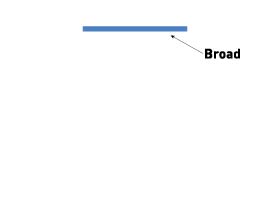
The mission statement also indicates that, in addition, they should receive in-depth instruction in a specialized field of their choice. This T-shaped learning23 reflecting the breadth and depth of a good college education is similar to that offered by many other great universities.
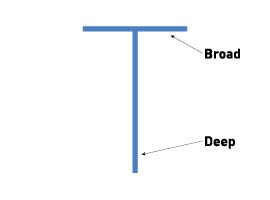
And while it is a necessary part of the unique educational experience we are to provide our students, it is not by itself sufficient to achieve our more ambitious aim of helping them realize their full divine potential. In order to do that, we have to ensure that the educational process is spiritually strengthening.
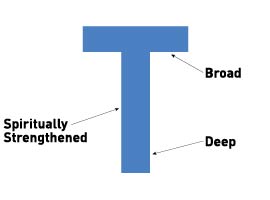
Notice that this important component covers all the knowledge we are conveying. It is not an appendage to the general or specialized curriculum; it is an essential part of every aspect of the learning process.
Finally, the education will not be complete until the key principles are cemented into the character of our students—until the learning becomes part of who they are.
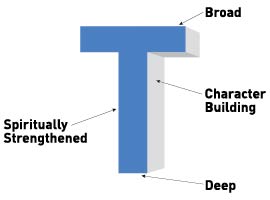
If we achieve the full aims of our mission, what starts out looking like the kind of education that is provided by other great universities takes on a distinctive and—eventually, I might suggest—unique shape:
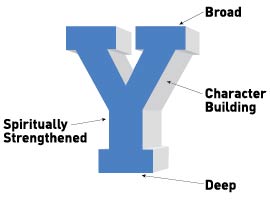
In a sense then, our own iconic symbol can convey the kind of unique educational experience we hope to provide to our students. We might say that the letter Y explains why—W-H-Y—we exist and what we hope to accomplish.
The photograph of new freshmen forming the Y in today’s Universe then takes on new meaning, reminding us that the students are the Y and the why.
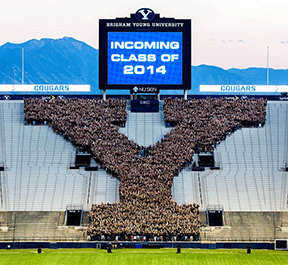
Photography by Jaren Wilkey
And now we reach the critical stage of the discussion—the portion that President Boyd K. Packer often calls the “therefore, what?” part.24 What do these concepts in the mission statement mean to each of us individually? What do I hope you take away from this meeting? There are two things in particular—both of them fairly simple but, I think, fairly impactful.
First, I hope all will understand that each of us has a role to play in carrying out the mission that has been set for us by the BYU Board of Trustees. The mission statement assumes that all members of the BYU community will make their own contribution to the mission—not just at a secondary support level but also in the actual learning process. We tend to think of that domain as belonging exclusively to the faculty, but the mission statement makes it clear that not just formal instruction but all programs and all services “should make their own contribution.” And this contribution is not limited just to the indirect kind of contribution to learning that is made by keeping the classrooms clean and functional or providing food in between classes. Each individual is to make his or her own contribution directly to the kind of learning experience that leads to “the balanced development of the total person.”25
More of you than you realize may be involved in the intensive learning process. Speaking of his university experience, when he worked part-time on the grounds and cleaning crews, President Henry B. Eyring observed:
Physics taught me to understand the changes occurring in the world at large. But the things I learned as a groundskeeper and a janitor were worth more in working with the Brethren. Among those is the expectation that you know your duty thoroughly, you do more than you’re asked, and you do it in a way that doesn’t stand out. 26
Second, once you realize you have a role, ask yourself repeatedly the key questions “What is that role?” and “How can I perform it better?” There are a variety of things that might be done to get answers to those questions. Let me suggest a couple.
First, become more familiar with the mission statement. You have been provided with copies of it and the aims document today. I urge each of you to read it and to reread it, even if you have read it many times before. As you do so, consider ways in which what you do can enhance the student experience and then strive to do that better.
Second—and this goes in tandem with rereading the mission and aims documents—seek inspiration. I firmly believe that through prayerful study you will receive insights that will improve not only your individual efforts but also, in some cases, the institution itself. I am convinced that many if not most of the ideas that will greatly improve the university in the coming years will not come from task forces impaneled by the central administration with a top-down agenda; instead they will come from individual departments, bringing to light concepts and practices that will benefit not just those departments or units but the entire university. Many of the current university-wide programs that benefit thousands of students originated in the minds and practices of individual faculty and staff.
The potential results of these kinds of efforts are spelled out in the last sentence of the mission statement:
We believe the earnest pursuit of this institutional mission can have a strong effect on the course of higher education and will greatly enlarge Brigham Young University’s influence in a world we wish to improve. 27
Note the difference in the two key verbs. The earnest pursuit of this mission can have a positive impact on the course of higher education. I believe it likely that some of the ideas we generate here will ripple throughout other universities in positive ways. But the mission statement describes that impact only in terms of possibilities.
By contrast, the other result of our earnest pursuit of this inspired mission seems more certain. It “will greatly enlarge” the influence of the university, not just in the realm of higher education but also in the world at large.
Let me cite one of many examples I could give of how this may occur. This particular example also demonstrates how some of the distinctive ways in which we do things prepares our graduates to compete “with the best in their fields,” as the mission statement challenges us to do.
A year ago a story in the New York Times Magazine—headlined “When Hollywood Wants Good, Clean Fun, It Goes to Mormon Country”—highlighted the work of the BYU Center for Animation, which operates under the direction of three colleges: the Ira A. Fulton College of Engineering and Technology, the College of Fine Arts and Communications, and the College of Physical and Mathematical Sciences.
The author of the article, Jon Mooallem, first described the type of animated short films that BYU students have produced during the last fourteen years. He then stated:
Those films have consistently racked up student Emmys and student Academy Awards. They’ve played at Cannes and Sundance. Most important, they’ve impressed recruiters. Out of nowhere, BYU—a Mormon university owned and operated by The Church of Jesus Christ of Latter-day Saints—has become a farm team for the country’s top animation studios and effects companies. Unlikely as it sounds, young Mormons are being sucked out of the middle of Utah and into the very centers of American pop-culture manufacturing.28
Now he might have said they are prepared to compete “with the best in their fields”—the terms used in the mission statement.
Mooallem continued, describing what I would call the influence these graduates can have on the world:
The BYU program is designed to be a . . . kind of ethical counterweight: it’s trying to unleash values-oriented filmmakers into the industry who can inflect its sensibility. “Without being preachy about it,” [Professor R. Brent] Adams told me, “if we can add something to the culture that makes people think about being better human beings—more productive, more kind, more forgiving—that’s what we want to do.”29
Mooallem continued:
At first I struggled to understand the specifics of that mission. Everyone talked about wanting to make “clean movies” or “movies I wouldn’t be afraid to take my mother to,” but these phrases were shibboleths, loaded and tough to pin down. It wasn’t simply a matter of avoiding sex and violence. . . . There was, instead, a fixation on whether you walked away from the movie feeling uplifted. That question superseded everything, even the usual genre and age-demographic lines.30
The world—at least the animation world—is noticing the difference.
Mooallem went on to say:
The industry has found a new breed of employee in Utah. One recruiter from Sony Animation Pictures described the typical BYU grad as . . . equipped with “a different mind-set.” In most animation programs, each student leads production on his or her own film. But at BYU, everyone works as a team on a single film because, unlike at art schools, students are too busy with religion courses and other requirements to be full-time filmmakers. Out of necessity, production on each year’s film winds up mirroring the way the industry actually works. BYU students emerge committed to a specialty and to collaboration—prepared for an entry-level job. 31
Notice how our distinctiveness, religion courses, and “other requirements”—which might include ward or family responsibilities—caused the BYU Animation Center to do things in a different way that turns out to be a better way.
Returning to the story:
“Honestly,” says Marilyn Friedman, the former head of outreach at DreamWorks, who visited BYU frequently, “the first few times I went to Provo, I was like: What am I doing here? I’m a little Jewish girl from back East. But I was just amazed by how absolutely lovely those kids are. They couldn’t be nicer, humbler, more respectful. It’s a pleasure. And when they come here, they stay that way.”32
The author of the article added:
Many of the students I met in Provo grew up in insular Mormon communities. They came from what’s dismissed as flyover country. They don’t smoke or drink, and I noticed that one faculty member, for example, kept saying, “Holy schnikeys!” whenever he wanted to curse. And yet creative types in Hollywood kept raving to me about how much “more worldly” these Mormons were than the moody, Gen Y art-school grads coming out of New York and Los Angeles and how grateful they were to have them onboard. This cut against so many different stereotypes—of Mormons, of Hollywood, of tortured artsy kids—and at the oddest angles. By coincidence, it seemed, Mormon culture was grooming its young people to be ideal employees of the same industry it predisposed them to be wary of.33
Mooallem concluded with an observation that may prove prophetic:
I kept being reminded that BYU’s program was only 13 years old: most of the moral emissaries that it has been pouring into the industry are still climbing to the positions from which they’ll be able to truly influence a film’s tone and content. One day there will be alumni directing and producing, students insisted—it’s an inevitability. “Right now we’re the workhorses,” an alumnus at DreamWorks told me. “But I think our future is bright in terms of being able to shape the industry.”34
What an example of how “the earnest pursuit of this institutional mission . . . will greatly enlarge Brigham Young University’s influence in a world we wish to improve.”
I close with observations about two key parts of the first sentence of the mission statement that I rushed by in my earlier remarks. I skipped them not because they are not important but precisely because they are, and I wanted to highlight them.
First, note that even though the mission statement focuses on students, the broad mission of the university is to assist “individuals” in their quest for perfection and eternal life. Given the student-centric nature of the mission statement and the educational enterprise in which we are engaged, I would have expected that phrase to read, “assist studentsin their quest for perfection and eternal life.” But the mission statement uses the broader term individuals. To me this suggests that while our efforts ought to be focused on the students and what happens to them, the results of that focus may assist others in their quest for perfection and eternal life. Let me cite as one example the experience of one of our lesser-known founders.
I must confess that until I had an office on the third floor of the ASB, I thought that Karl G. Maeser was the first academic leader of this institution. While Maeser is rightly credited with being one of its key founders, he was not the first principal of Brigham Young Academy, as many of you know. I learned this early in my tenure as advancement vice president when I walked down the hall and saw pictures of the presidents of BYU ending with President Cecil O. Samuelson but beginning, much to my surprise, not with Karl G. Maeser but with Warren Dusenberry, who was the principal of Brigham Young Academy during what was called its experimental term from January 3, 1876, to April 15 of that year—a period of only four months, not much longer than I have been in office.
Warren Dusenberry was born in 1836 in Pennsylvania.35 When he was five years old, his family moved to an area near Hannibal, Missouri, where, five years later, his mother, Aurilla, joined The Church of Jesus Christ of Latter-day Saints. His father, Mahlon, did not join his wife in that action, and neither did Warren or his brother Wilson. In April 1860, when Warren was twenty-three years old, the Dusenberry family made their way to California. After two years there, Aurilla and Mahlon reached the breaking point over religion, and she left for Utah with Warren, Wilson, and their two sisters.36 Mahlon’s instruction to his son Wilson was to keep himself “free from the curse of Mormonism.”37
Although he was not a member of the Church, Warren’s first job in Provo was as a teacher in the First Ward School, with classes conducted in the basement of the original tabernacle.38 Focusing as he did on the well-being of the students, Warren invested fifty dollars of his own money to buy textbooks for the first school.39
Wilson sometimes substituted for his brother and recorded in his journal some of what he called the “botherations”40 of teaching in a pioneer town. After one particularly trying day, he wrote, “The little brats were determined on having a spree. [I] checked their cheer a little, however.”41
In the fall of 1863 the brothers decided to start their own school, which in later years many viewed as the real predecessor of Brigham Young Academy. The brothers were “the only teachers, administrators, and janitors”42 of the new Dusenberry School. The finances were so tight that they were forced to live at the school, at first sleeping on the floor.43 When after several months they acquired a bed, Wilson recorded his one-word reaction in his journal: “Wonderful!” 44
The financial strain eventually grew too heavy, and the brothers closed the school after two years.45 The school reopened four years later in 1869,46 and shortly thereafter it became the Timpanogos Branch of the University of Deseret, with Warren operating as the principal.47 The school stayed afloat for six years, until financial problems once again caused the school to go under in 1875. It was in April of that year that Wilson wrote a letter to Brigham Young informing him that they could not go on without some additional financial help.48 In response, President Young informed them that he would not sustain their school because he had decided to endow a new institution of learning, and Warren set to work drawing up some plans.49
In the fall of 1875 President Young established Brigham Young Academy, and Warren was appointed as its first principal.50 The appointment was from the outset intended to be temporary, as Warren had over time become involved in other activities.51 As planned, he resigned after the 1876 spring experimental term to make way for Karl G. Maeser.52
Warren and Wilson Dusenberry dedicated eight years of their lives to the education of youth in Provo, sacrificing their means, their time, and their comfort “toward the balanced development of the total person.” As Warren and Wilson focused on the well-being of their students, their attitude toward them changed. Whereas early on Wilson described the students as “botherations” and “brats” whose cheer needed to be checked, he later recorded, “Who can teach school without forming ties of affection? Not I.”53 The Dusenberrys’ capacity to take joy from seeing students grow had increased because of their focus on the well-being of their students.
But their association with the students and others in the community had an even more fundamental impact on them. On July 24, 1864, during their first year of teaching in Provo, Warren told Wilson that he was ready to be baptized, and both of them were—on that very day.54
Among those individuals whose quest for perfection and eternal life were aided by the educational efforts of Warren and Wilson Dusenberry, none was affected more profoundly than the Dusenberrys themselves.
That may be the case with us as well. The “individuals” whose quest for perfection and eternal life is assisted by our efforts at BYU may include not only the students who attend here but also those who are changed by their interaction with those students now and in the future, including ourselves.
Finally, there is the phrase in the mission statement that we too often completely skip over: “founded, supported, and guided by The Church of Jesus Christ of Latter-day Saints.”55 As important as it is to remind ourselves constantly that students are the focus of our efforts, it is equally important to always remember the source of not only our founding and our funding but also our direction.
We are blessed to be led by those who are prophets, seers, and revelators. It was the inspiration given to such individuals, starting with Brigham Young, that has brought us to this point. And it will be their inspiration and vision that will guide us in the future. We will fulfill our mission only to the extent that we accept and follow that guidance. As the mission statement says, “To succeed in this mission the university must provide an environment enlightened by living prophets.”56
Along the way, those living prophets have provided us glimpses of the destiny of this place. You are familiar with them from Brigham Young and John Taylor and onward. I close with one of my favorites, from President Spencer W. Kimball:
I am both hopeful and expectant that from this university there will rise brilliant stars in drama, literature, music, art, science, and all the scholarly graces. This university can be the refining host for many such individuals who in the future, long after they have left this campus, can lift and inspire others around the globe. . . .
As previous First Presidencies have said, we say again to you: “We expect—we do not merely hope—that Brigham Young University will become a leader among the great universities of the world.” To that expectation I would add, “Remain a unique university in all the world!” Then, in the process of time, this truly will become the fully recognized university of the Lord about which so much has been spoken in the past.57
May we go forward in this great cause with energy, enthusiasm, and inspiration. I bear my witness that Heavenly Father is aware of our efforts. He is interested in our efforts, both for our benefit and for that of our students. If we will but focus in on what our mission is, we will be blessed to raise the stature of the university and, more important, affect the lives of thousands of our students. I bear you that witness in the name of Jesus Christ, amen.
Notes
1. D&C 128:22.
2. Moses 1:39.
3. The Mission of Brigham Young University and The Aims of a BYU Education (Provo: BYU, 2014), 1.
4. D&C 128:1.
5. See A. LeGrand Richards, Called to Teach: The Legacy of Karl G. Maeser (Provo: Religious Studies Center, BYU; Salt Lake City: Deseret Book, 2014), xxxvi–xxxviii, 565–66; see also “Maeser Chalkboards Preserved,” education.byu.edu/news/2005/01/01/maeser-chalkboards-preserved.
6. Richards, Called to Teach, xxxvi, xxxviii, 565.
7. Mission and Aims, 1.
8. Dallin H. Oaks, “Response,” Addresses Delivered at the Inauguration of Dallin Harris Oaks (Provo: BYU Press, 1971), 18; emphasis in original; quoted in Ernest L. Wilkinson, ed., Brigham Young University: The First One Hundred Years, 4 vols. (Provo: BYU Press, 1975–76), 4:64.
9. Oxford English Dictionary Online, s.v. “intensive,” oed.com/view/Entry/97480?redirectedFrom=intensive.
10. George Sutherland, A Message to the 1941 Graduating Class of Brigham Young University from Justice George Sutherland (Provo: Brigham Young University, 1941), 9; quoted in Ernest L. Wilkinson and W. Cleon Skousen, Brigham Young University: A School of Destiny (Provo: BYU Press, 1976), 122; also quoted in Richards, Called to Teach, xxxiv–xxxv.
11. Mission and Aims, 2.
12. Oaks, “Response,” 19; quoted in First One Hundred Years, 4:64.
13. Mission and Aims, 1.
14. Mission and Aims, 2.
15. “The Family: A Proclamation to the World,” Ensign, November 1995, 102.
16. Oaks, “Response,” 18; emphasis in original; quoted in First One Hundred Years, 4:64.
17. Mission and Aims, 1.
18. Mission and Aims, 1–2.
19. Spencer W. Kimball, “Education for Eternity,” pre-school address to faculty and staff, Brigham Young University, 12 September 1967; see also excerpted text in “Climbing the Hills Just Ahead: Three Addresses” in John W. Welch and Don E. Norton, eds., Educating Zion (Provo: BYU Studies, 1996), 54.
20. Karl G. Maeser, “Final Address” (4 January 1892), The Normal 1, no. 10 (15 January 1892): 82.
21. Orson Pratt, JD 7:157 (12 February 1860); quoted in Terryl L. Givens, “Introduction: No Small and Cramped Eternities: Parley Pratt and the Foundations of Mormon Cosmology,” in Parallels and Convergences: Mormon Thought and Engineering Vision, A. Scott Howe and Richard L. Bushman, eds. (Salt Lake City: Greg Kofford Books, 2012), xii.
22. Mission and Aims, 5.
23. I express appreciation to Dean Lee T. Perry of the BYU Marriott School for suggesting both the use of the “T” visualization and the insight into the need for adding the spiritual dimension to the image.
24. As related by Jeffrey R. Holland in “Teaching, Preaching, Healing,” Ensign, January 2003, 37.
25. Mission and Aims, 1.
26. Robert I. Eaton and Henry J. Eyring, I Will Lead You Along: The Life of Henry B. Eyring (Salt Lake City: Deseret Book, 2013), 53.
27. Mission and Aims, 2.
28. Jon Mooallem, “When Hollywood Wants Good, Clean Fun, It Goes to Mormon Country,” New York Times Magazine, 23 May 2013, nytimes.com/2013/05/26/magazine/when-hollywood-wants-good-clean-fun-it-goes-to-mormon-country.html?pagewanted=all&_r=0.
29. Mooallem, “When Hollywood.”
30. Mooallem, “When Hollywood.”
31. Mooallem, “When Hollywood.”
32. Marilyn Friedman, quoted in Mooallem, “When Hollywood.”
33. Mooallem, “When Hollywood.”
34. Mooallem, “When Hollywood.”
35. See First One Hundred Years, 1:32.
36. See First One Hundred Years, 1:32–33, referencing Robert Kelly Dusenberry, “Warren Newton Dusenberry: Prominent Utah Pioneer, Educator, Judge, and Public Servant, 1836–1915,” unpublished typescript, 1971, L. Tom Perry Special Collections, Harold B. Lee Library, Brigham Young University.
37. Diary of Wilson H. Dusenberry, 25 April 1863; quoted in First One Hundred Years, 1:33.
38. See First One Hundred Years, 1:35.
39. See First One Hundred Years, 1:36.
40. Diary of Wilson H. Dusenberry, 5 November 1863; quoted in First One Hundred Years, 1:36.
41. Diary of Wilson H. Dusenberry, 20 February 1863; quoted in First One Hundred Years, 1:36.
42. First One Hundred Years, 1:39.
43. See First One Hundred Years, 1:39.
44. Diary of Wilson H. Dusenberry, 17 December 1863; quoted in First One Hundred Years, 1:40.
45. See First One Hundred Years, 1:45.
46. See First One Hundred Years, 1:45, 47.
47. See First One Hundred Years, 1:52–53.
48. See First One Hundred Years, 1:61, referencing letter from Wilson H. Dusenberry to Brigham Young, 5 April 1875.
49. See First One Hundred Years, 1:61–62.
50. See First One Hundred Years, 1:65–66.
51. See First One Hundred Years, 1:66.
52. See First One Hundred Years, 1:75.
53. Diary of Wilson H. Dusenberry, 6 November 1863; quoted in First One Hundred Years, 1:38.
54. See First One Hundred Years, 1:43.
55. Mission and Aims, 1.
56. Mission and Aims, 1.
57. Spencer W. Kimball, “Installation of and Charge to the President,” Inaugural Addresses, 14 November 1980, Brigham Young University, 9, 10; see also excerpted text in Educating Zion, 77, 78.
© Brigham Young University. All rights reserved.
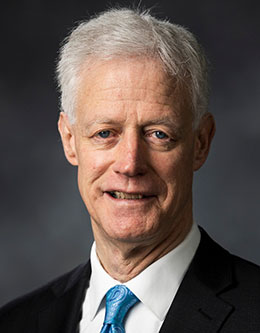
Kevin J Worthen was president of Brigham Young University when this address was given at the BYU annual university conference on 26 August 2014.


